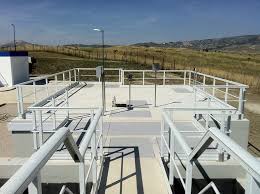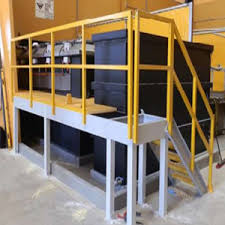- Home
- »
- Fibergrating's Blog
- »
- Safety Standards And Regulations For Fiberglass Handrails
Table of Contents
Safety Standards And Regulations for Fiberglass Handrails
Fiberglass handrails, fencing, and guardrail systems must adhere to various safety standards and regulations to ensure their reliability and effectiveness in different settings. These systems are designed and customized to meet the Occupational Safety and Health Administration (OSHA) requirements, particularly Section 1910.28, which focuses on fall protection and protection from falling objects.
This regulation requires employers to implement proper railings to safeguard workers from falls at elevated work areas, emphasizing the importance of safety in both industrial and construction environments.
ASTM E-84 Standard For Fiberglass Handrail System
Additionally, fiberglass handrail systems are crafted using materials with Class I fire retardance, meeting the ASTM E-84 standard with a flame spread rating of 25 or below. This compliance with fire safety standards ensures the systems are effective in reducing fire risks. The use of non-metallic components for connections further reduces corrosion, making fiberglass handrails an excellent choice for harsh environments like chemical processing and wastewater treatment facilities.

The ASTM E-84 test measures two key indexes
Flame Spread Index (FSI): This index indicates how rapidly flames can travel across the surface of a material. A lower FSI value suggests that the material is less likely to contribute to the rapid spread of fire, which is crucial in maintaining safety and providing occupants with more time to evacuate in the event of a fire.
Smoke Developed Index (SDI): This index quantifies the amount of smoke produced when a material burns. Since smoke inhalation is a leading cause of fatalities in fires, materials with a lower SDI are preferred because they produce less smoke, reducing the risk to human health during a fire.
MASH For Guardrail Systems
Guardrail systems also need to meet specific safety criteria established by bodies like the American Association of State Highway and Transportation Officials (AASHTO) and the Federal Highway Administration (FHWA). These organizations have developed the Manual for Assessing Safety Hardware (MASH), which sets forth performance standards for guardrail crashworthiness and installation procedures, ensuring guardrails are capable of mitigating risks during vehicle collisions.
Local Codes And Regulations In Fiberglass Handrails
Local codes and regulations also influence the installation of fencing and guardrails. Municipalities may enforce specific requirements concerning the height, placement, and materials of these barriers to uphold safety and visual harmony within communities. It is crucial for individuals and companies to consult local zoning and city planning departments before starting any fencing or guardrail installations.
Compliance With Safety Standards
In conclusion, compliance with safety standards for fiberglass handrails and guardrail systems involves a comprehensive approach, including OSHA guidelines for workplace safety, adherence to fire safety ratings, and alignment with national and local installation regulations. Understanding and following these multifaceted requirements are essential for maintaining effective and safe barrier systems.
Contact Us
For more information about our compliant fiberglass handrails, fencing, and guardrail systems, or to request a quote, please reach out to us.
Our team is ready to assist you with any questions or project needs!

Comments
Frequently Asked Question
Fiberglass handrails and guardrails must comply with OSHA standards, specifically Section 1910.28 for fall protection, and ASTM E-84 for fire safety. Guardrail systems must also adhere to crashworthiness standards set by AASHTO and FHWA’s Manual for Assessing Safety Hardware (MASH).
Fiberglass handrails use non-metallic hardware that resists corrosion, making them ideal for harsh environments like chemical plants and wastewater treatment facilities. This durability extends their lifespan and reduces maintenance needs compared to traditional metal railings.
Fiberglass handrail systems are required to have a Class I fire retardance rating and meet the ASTM E-84 flame spread rating of 25 or less. This ensures the materials used can effectively slow the spread of fire, enhancing safety in various settings.
Yes, local regulations may dictate specific requirements for the height, placement, and materials used in fencing and guardrails. It is important to consult with local city planning or zoning departments to ensure compliance with these rules before installation.

